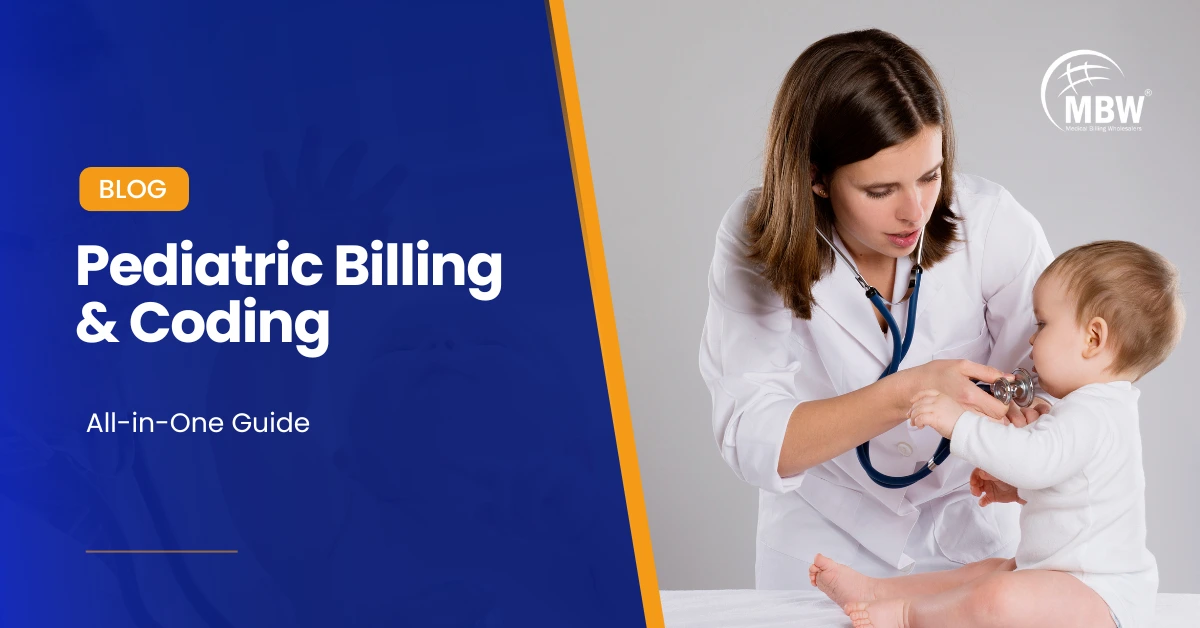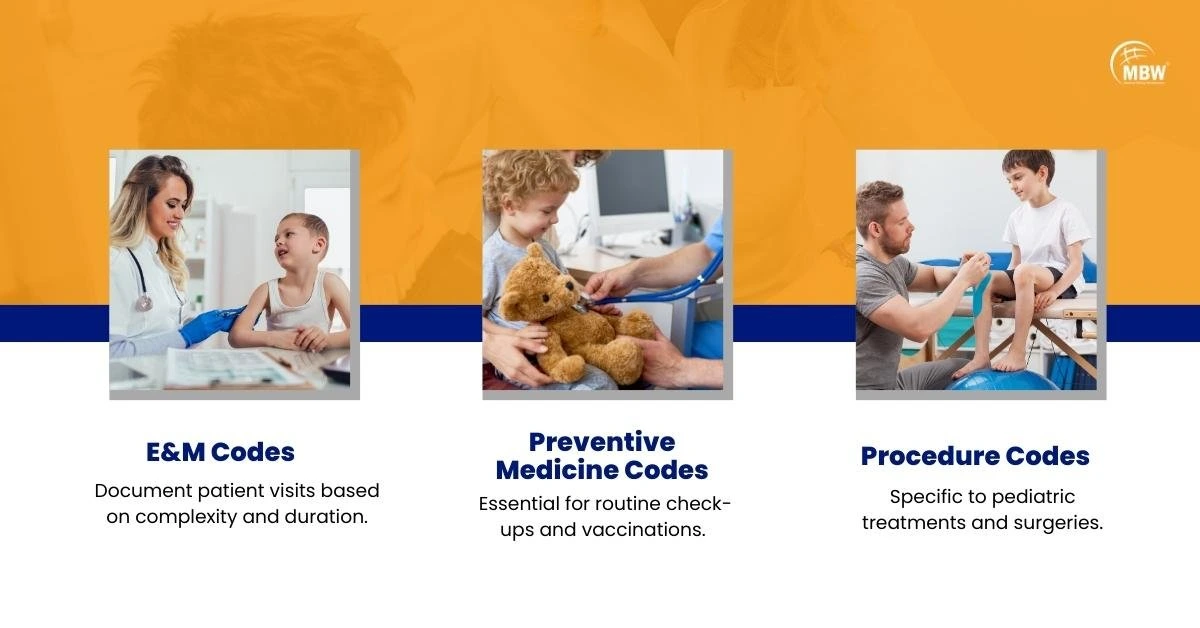 Understanding pediatric billing and coding can be daunting due to the specific needs of children and the evolving nature of healthcare.
This guide simplifies the complexities, helping you master pediatric billing and coding. It’s designed for physicians, doctors, medical billers, and coders who focus on pediatric care. We’ll cover essential codes, documentation tips, common denial reasons, and best practices.
Let’s dive in and make pediatric billing and coding a breeze!
Understanding pediatric billing and coding can be daunting due to the specific needs of children and the evolving nature of healthcare.
This guide simplifies the complexities, helping you master pediatric billing and coding. It’s designed for physicians, doctors, medical billers, and coders who focus on pediatric care. We’ll cover essential codes, documentation tips, common denial reasons, and best practices.
Let’s dive in and make pediatric billing and coding a breeze!
What is Pediatric Billing and Coding?
Pediatric billing and coding involve using specific medical codes to document and bill for healthcare services provided to children. It ensures accurate communication between healthcare providers and insurance companies, facilitating proper reimbursement for services rendered. This specialty requires a thorough understanding of pediatric-specific codes and guidelines to navigate the unique aspects of pediatric healthcare.Overview of Pediatrics
Pediatrics focuses on the physical, mental, and social health of children from birth to young adulthood, encompassing various specializations. Key areas include neonatology, emergency pediatric medicine, critical care, cardiology, rheumatology, pulmonology, and developmental behavioral pediatrics. Each specialization addresses unique aspects of pediatric health, from premature infants to adolescents up to 18 years old. Understanding these age groups is crucial for accurate billing and coding, as specific codes and services apply to each group.| S.No | Group | Age |
|---|---|---|
| 1 | Neonate | Birth to 28 Days |
| 2 | Post Neonate | 29 days to less than 1 year |
| 3 | Toddler | 1 year to 36 Months |
| 4 | Preschool Child | 3 years to 5 years old |
| 5 | School-aged Child | 6 Years to 9 Years |
| 6 | Adolescence | 10 Years to 18 Years |
Common Pediatric Billing and Procedure Codes
 Evaluation and Management (E&M) codes are vital for documenting patient visits, varying based on visit complexity and duration. Preventive medicine codes cover routine check-ups and vaccinations, essential for child health maintenance.
Procedure codes address pediatric-specific treatments and surgeries.
Here are the critical codes:
Evaluation and Management (E&M) codes are vital for documenting patient visits, varying based on visit complexity and duration. Preventive medicine codes cover routine check-ups and vaccinations, essential for child health maintenance.
Procedure codes address pediatric-specific treatments and surgeries.
Here are the critical codes:
| S.No | Code Series | Description |
|---|---|---|
| 1 | 99202-99205 | New patient office/outpatient visits |
| 2 | 99211-99215 | Established patient office/outpatient visits |
| 3 | 99381-99384 | Preventive check-ups for new patients |
| 4 | 99391-99394 | Preventive check-ups for established patients |
| 5 | 54150 | Circumcision using clamp or other device |
| 6 | 54160 | Surgical circumcision |
| 7 | 36510 | Central venous catheter insertion |
| 8 | 90460 | Vaccination administration with counseling |
| 9 | 90461 | Vaccination administration without counseling |
Common Vaccines Administered for Pediatrics
Vaccination is a critical aspect of pediatric care, requiring specific codes for accurate billing. These codes ensure proper documentation and facilitate accurate billing for vaccines and preventive care.
| S.No | Vaccine Code | Description |
|---|---|---|
| 1 | 90686 | Influenza virus vaccine, quadrivalent (IIV4), split virus, preservative-free, 0.5 mL dosage, for intramuscular use |
| 2 | 90688 | Influenza virus vaccine, quadrivalent (IIV4), split virus, 0.5 mL dosage, for intramuscular use |
| 3 | 91318 | Severe acute respiratory syndrome coronavirus 2 (SARS-CoV-2) (coronavirus disease [COVID-19]) vaccine, mRNA-LNP, spike protein, 3 mcg/0.3 mL dosage, tris-sucrose formulation, for intramuscular use |
| 4 | 90633 | Hepatitis A vaccine (HepA), pediatric/adolescent dosage-2 dose schedule, for intramuscular use |
| 5 | 90744 | Hepatitis B vaccine, pediatric/adolescent dosage; 3 dose schedule, for intramuscular use |
| 6 | 90707 | Measles, mumps, and rubella virus vaccine (MMR), live, for subcutaneous use |
Documentation Tips
Accurate documentation ensures proper reimbursement and avoids claim denials. Document comprehensive patient history, physical exams, developmental milestones, and vaccination records thoroughly. Ensure parental consent is recorded for treatments, especially for adolescents.

Importance of Accurate Coding for Reimbursement
Accurate coding is critical for proper reimbursement in pediatric healthcare. Incorrect or incomplete coding can lead to claim denials, delays in payment, and financial losses for healthcare providers. By ensuring that all services are coded accurately and in compliance with the latest guidelines, providers can maximize their reimbursement rates and maintain financial stability. Regular audits and continuous education for coding staff are essential to maintain high coding accuracy.Addressing Common Billing Challenges
Handling pediatric billing involves specific challenges such as dealing with various insurance policies, ensuring compliance with constantly changing regulations, and managing claim denials. Here are a few common challenges in pediatric billing:- Inconsistent Documentation: Variability in documentation practices among healthcare providers can lead to billing errors and claim denials.
- Complex Insurance Policies: Navigating different insurance policies and payer requirements can be challenging, leading to incorrect billing and delayed payments.
- Frequent Code Updates: Keeping up with the frequent changes in pediatric billing codes and guidelines requires continuous education and system updates.
- Coordination of Benefits: Managing primary and secondary insurance claims for pediatric patients often results in processing delays and additional administrative work.
Key Strategies for Pediatric Billing and Coding
Understanding age-specific CPT and ICD-10 codes is crucial as many pediatric codes are specific to different ages, and using incorrect codes can lead to denials. Stay updated with the latest pediatric coding guidelines from the American Academy of Pediatrics (AAP) and other relevant organizations. Regular training for billing and coding staff is essential, along with using pediatric-specific EHR systems and implementing a quality assurance program to streamline processes. Leveraging technology, such as billing software with features like automatic code updates and real-time eligibility verification, enhances billing efficiency. Enhance your practice’s financial health with comprehensive revenue cycle services, including revenue cycle analytics for detailed insights. Conclusion
Conclusion
Pediatric billing and coding require specialized knowledge and attention to detail. By understanding the common codes, documentation requirements, and best practices, healthcare providers can improve their billing processes, reduce denials, and ensure proper reimbursement.
Frequently Asked Questions (FAQs) on Pediatrics Billing and Coding
What is a pediatric billing cheat sheet?
A pediatric billing cheat sheet is a handy reference guide that includes common pediatric codes, billing tips, and best practices. It helps streamline the billing process and ensures accuracy.
What are common pediatric billing codes?
Pediatric billing codes include a variety of CPT and ICD-10 codes specific to pediatric care. These codes are used to document services such as well-child visits, immunizations, and specific treatments.
What are some pediatric coding tips and tools?
Effective pediatric coding requires staying updated with the latest guidelines, using age-specific codes, and leveraging coding tools such as EHR systems and coding software to ensure accuracy and efficiency.
What are the pediatric billing guidelines?
Pediatric billing guidelines are provided by organizations such as the AAP and CMS. These guidelines cover coding practices, documentation requirements, and regulations to ensure proper billing and reimbursement.
What age is CPT code 99395 for?
CPT code 99395 is for preventive health visits for established patients aged 18 to 39 years.
What is the difference between G0444 and 96127?
G0444 is for annual depression screening, while 96127 is for brief emotional/behavioral assessment.
What is pediatrics in medical billing?
Pediatrics in medical billing involves using specific codes to document and bill for healthcare services provided to children, ensuring accurate communication and proper reimbursement.
What is the CPT code for a child?
CPT codes for children vary based on the service provided. Common codes include 99381-99385 for preventive visits and specific codes for vaccinations and treatments.
What are the coding guidelines for pediatric preventive care in 2024?
Coding for pediatric preventive care in 2024 includes updated guidelines for well-child visits, immunizations, and screenings as outlined by the AAP and CMS.
What is the age limit for CPT code 99381?
CPT code 99381 is for new patient preventive visits for infants younger than 1 year old.
What is the age limit for CPT code 99382?
CPT code 99382 is for new patient preventive visits for children aged 1 to 4 years.
Schedule a call with our leaders to transform your revenue cycle.
Contact us at [email protected] or fill out the form below. Discover how Medical Billing Wholesalers can help your healthcare organization succeed by visiting Medical Billing Wholesalers.

